|
Dick's Juniper Pictures |
|||
| Courtright
Reservoir Kaiser
Pass Area Eastern
Sierra Elsewhere
in California
Other States More Photos Links of Interest Juniper Slide Show |
|||
|
New photos added here August 28 and here October 28, 2019 (captions in red) |
|||
|
|||
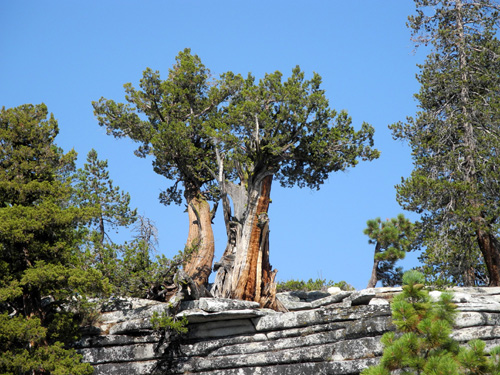 |
|||
|
Along with sequoias, bristlecone pines, and red firs, junipers are my favorite trees. A very few are tall, straight and full. Most are twisted and gnarly, with dead branches and tops; sometimes there's just one live branch on a large, rugged tree. They grow in rocky, high elevation locations where few other trees can even get a start. Like Laurie, I'm tempted to photograph every one I see. There are three main species pictured here. The Sierra Juniper (AKA Western Juniper), as its name implies, is native to California's Sierra Nevada mountains. They are also found in areas of Washington, Oregon, Idaho and Nevada. They are divided into two subspecies, occidentalis in the northern part and australis in the southern part of their range. Some experts think they are two separate species. I don't care - I just like seeing and photographing them. There are probably trees of two other species shown here. The Utah Juniper is native to Utah, Nevada, Arizona, and parts of New Mexico, Colorado, Wyoming, Montana, Idaho and extreme eastern California. In my experience, they tend to grow to a lesser height than their western cousins, but their overall appearance and growth patterns are similar. The Rocky Mountain Juniper occupies much of the same territory, but extends into Canada, Texas and Mexico. They are the smallest of the three species I've encountered, and in areas outside the Sierra, I don't know which one I'm seeing. Information on the age of these trees is confusing. The tree considered to be the oldest and largest is "possibly 3,000 years old." Another source gives the typical age at maturity as 1,000 years. Individual trees have been verified to be as much as 2,600 years old. The oldest verified Rocky Mountain specimen is 1,500 years of age. Hug a tree, but be careful if it's a juniper. The reddish bark of the western species, and the grayish bark of the others is stringy and rough, part of what makes these conifers such a visual delight. --Dick Estel, September 2016 |
|||
| Click photo for a larger view (pictures open in a new window) | |||
The
Junipers of Courtright Reservoir
|
|||
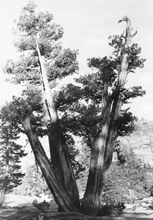 |
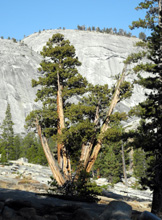 |
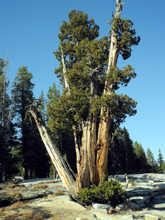 |
|
| Probably the first juniper I ever photographed, about 1970 | 2016 photo of the same tree | A slightly different angle | |
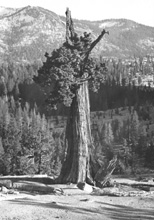 |
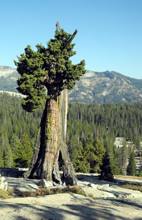 |
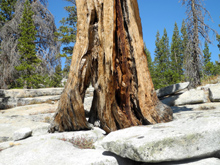 |
|
| Tree below the Maxson Trailhead road, photographed on a hike about 1970 | This tree has filled out on top over the course of 45 years | It has a hole through the base | |
 |
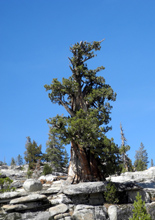 |
 |
|
| This tree is above the road on a rock cliff; I call it the Shelf Juniper | It's distinctive shape made it easy to locate for a 2016 photo | A wider view of the tree's location | |
 |
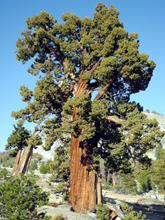 |
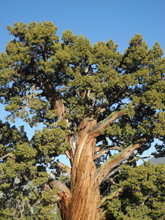 |
|
| This tree hasn't suffered much "pruning" from the elements | The passage of 45 years has thinned the branches slightly | A closer look at the top of the tree | |
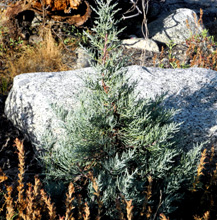 |
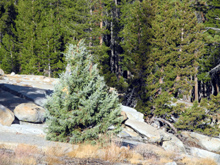 |
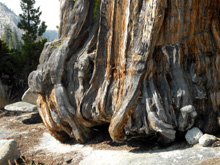 |
|
|
How those ancient junipers start out |
Another "youngster" | Base of an ancient, living juniper | |
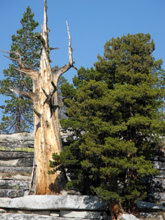 |
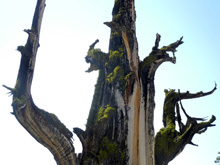 |
 |
|
| The Sentinel: It's ancient, it's gnarly, it's dead | The mossy top of the dead juniper | The dead tree stands in front of a 15 foot high rock cliff | |
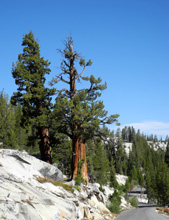 |
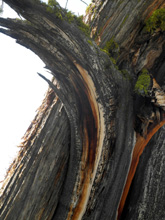 |
 |
|
| Tree along the road a short distance before the dam | Detail of bark on a live tree | More bark beauty | |
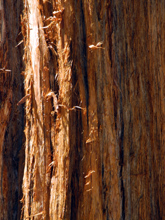 |
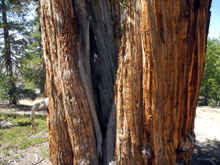 |
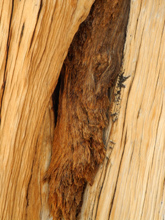 |
|
|
The striking red bark has caused junipers to be called "red cedar" |
A wider view of the rugged base |
A bit of bark still clings to this weathered trunk |
|
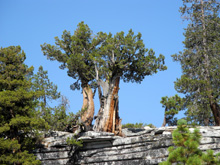 |
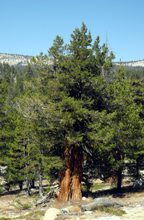 |
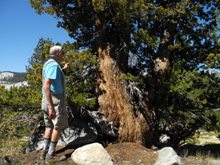 |
|
|
One of my favorite scenes in the entire area |
A fairly straight and full tree above the trailhead parking lot | Taking a closer look | |
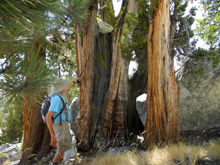 |
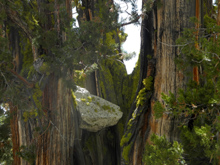 |
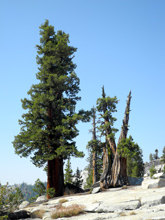 |
|
| Pondering how the rock got up in the tree | The most probable theory - the rock fell from the cliff above | A rare straight, tall juniper | |
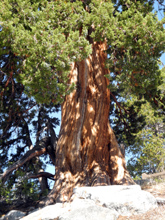 |
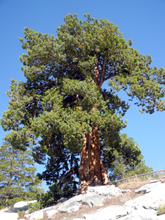 |
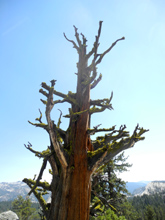 |
|
| Big juniper near the LeConte Overlook | A longer view of the overlook tree | This tree at the base of Constant Dome appears to be dead | |
 |
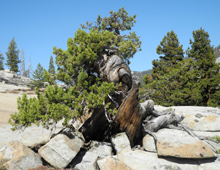 |
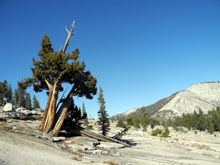 |
|
| But a closer look reveals some life | This one is small in size, but the trunk reflects many years facing the elements | Dead top rises above this rugged tree on the slope above camp | |
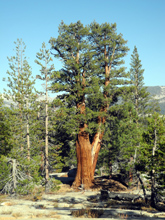 |
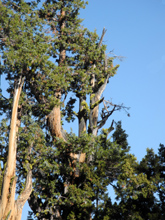 |
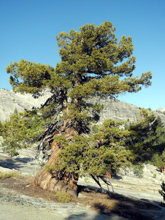 |
|
|
I almost didn't walk down to this tree below the road, but was glad I did |
The broken top has been replaced by multiple tops | Not very tall, but clearly strong against the winter winds | |
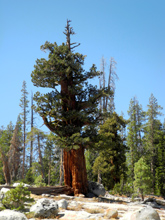 |
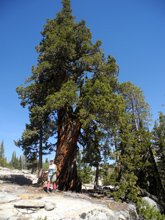 |
 |
|
| This tall, straight specimen almost looks like a Sequoia | Teri stands by this tree to give perspective on its size | A closer look | |
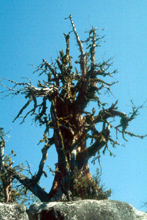 |
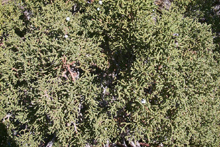 |
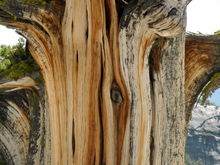 |
|
| Gnarly dead juniper above the Kings River North Fork canyon | Close-up of juniper foliage | A close-up of the trunk of the Sentinel Juniper | |
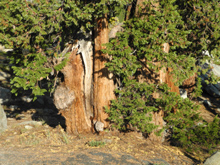 |
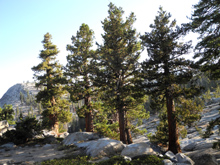 |
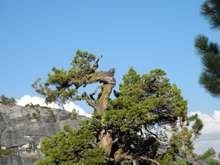 |
|
| A bunch of junipers growing together | The Big Four - similar in size, tall and straight, but junipers nevertheless | This tree hit the ceiling and grew sideways | |
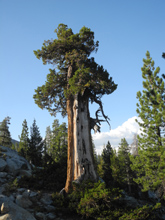 |
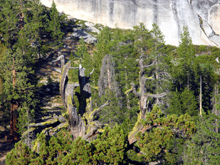 |
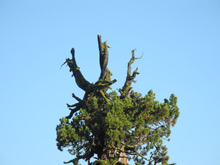 |
|
| The Bull Juniper - one of the finest specimens in the area | Looking down on the top of the Bull Juniper | The top as seen from down on the same level as the tree | |
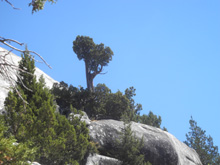 |
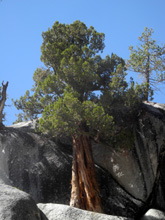 |
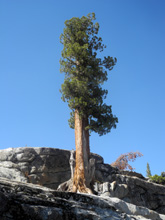 |
|
| Juniper in the rocks at the base of Double Dome | This one is just west of the trail, a quarter mile in from the parking lot | Along the "Juniper Trail" west of camp | |
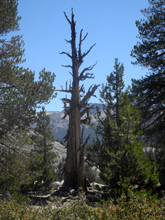 |
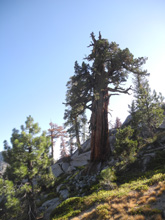 |
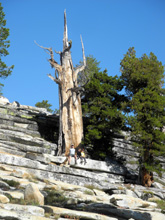 |
|
| Dead juniper just south of our camp | Another view of the Bull Juniper |
Rock scramblers on the shelf below the Sentinel Tree |
|
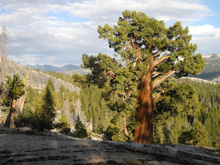 |
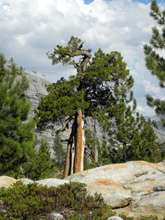 |
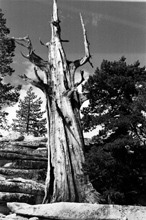
|
|
| The
late afternoon sun gives a special glow to Teri's Juniper |
We
call this one the Bull Juniper's Upstairs Neighbor |
The Sentinel Juniper in black and white, 2019 | |
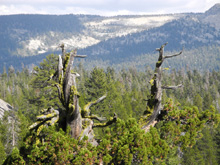 |
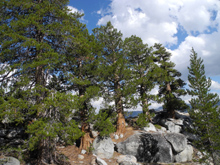 |
||
| The top of the Bull Juniper shows how the old patriarch has weathered the centuries | The Big Four from the west | ||
Kaiser
Pass Area
|
|||
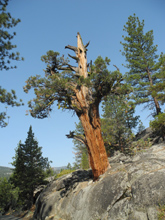 |
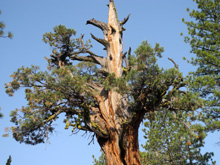 |
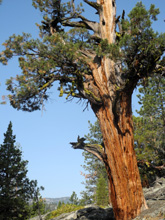 |
|
| Junipers thrive in the rocky areas around Mono Hot Springs | Harsh winters keep the trees "pruned" | I just kept taking pictures of this tree | |
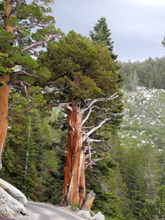 |
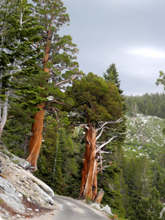 |
||
|
Juniper on the Kaiser Pass Road just west of the pass |
Another look at the Kaiser Pass trees | ||
Eastern Sierra
|
|||
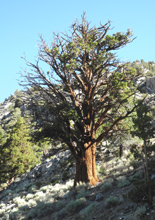 |
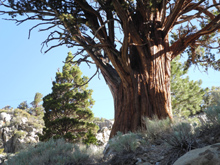 |
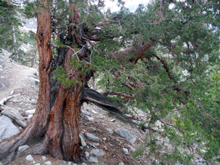 |
|
| Rugged juniper on June Lake Loop near Mono Lake | This one has an extra-thick trunk |
Another good size juniper near a trail out of Silver Lake |
|
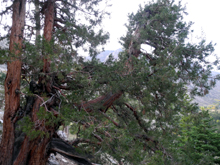 |
|||
|
It has a massive limb hanging out below the trail |
|||
| Elsewhere
in California
The junipers here were photographed in either Joshua Tree National Monument or the Mojave National Preserve unless otherwise indicated |
|||
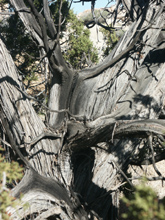 |
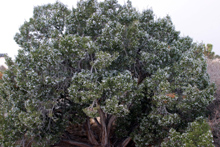 |
 |
|
| A very gnarly, tangled dead tree in Joshua Tree National Park | Thick, bushy specimen with a good crop of berries | Close look at juniper berries (they are actually cones) | |
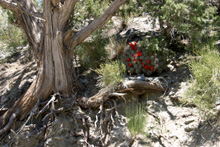 |
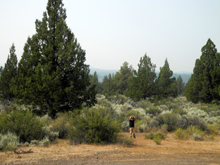 |
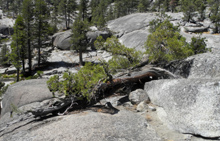 |
|
| This tree at a high point in the Mojave National Preserve shelters a blooming cactus | Sage brush and junipers in Lava Beds National Monument | A horizontal juniper above the Kings River North Fork | |
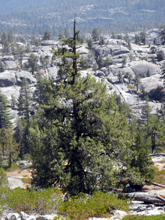 |
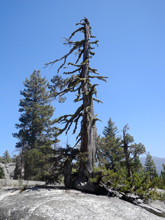 |
 |
|
| More junipers above Granite Gorge and Hell Hole on the North Fork of the Kings River | |||
| Other
States
These are mostly Utah Junipers, with possibly a Rocky Mountain specimen here and there |
|||
 |
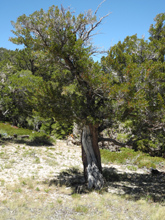 |
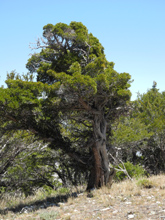 |
|
| Rugged juniper along US Highway 6 in Nevada | Juniper in Great Basin National Park, Nevada | Another specimen in Great Basin | |
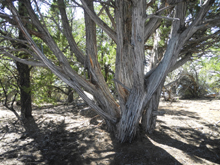 |
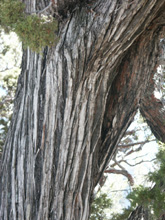 |
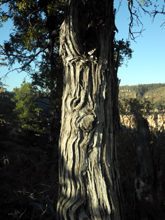 |
|
|
A multi-trunk juniper, Grand Canyon North Rim |
Tree
near Walhalla Overlook shows typical gray trunk of the Utah species |
Along the Bright Angel Trail in Grand Canyon | |
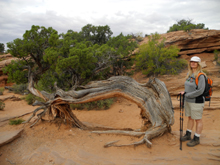 |
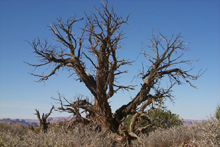 |
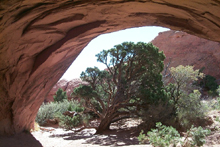 |
|
| Teri
and a hardy juniper on the Delicate Arch Trail, Arches National Park |
Near the Windows area of Arches National Park | View
of juniper tree looking out through Navajo Arch |
|
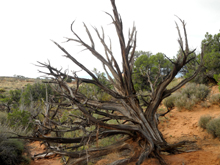 |
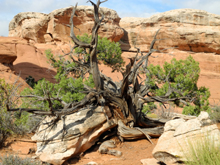 |
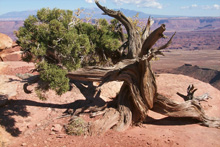 |
|
| Near Double Arch | Near Broken Arch |
Utah Juniper in Canyonlands National Park |
|
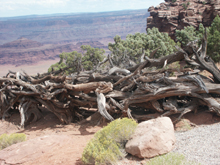 |
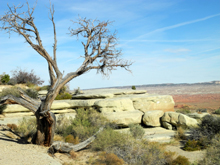 |
 |
|
| Corral of juniper branches
at Dead Horse State Park, Utah |
Juniper and white sandstone along I-70 | Juniper
in the Echo Park section of Dinosaur National Monument |
|
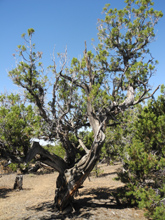 |
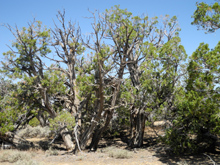 |
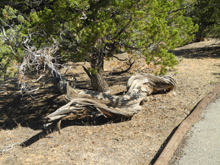 |
|
| At
the Plug Hat Picnic Area in Dinosaur National Monument |
Small stand of junipers in the Monument | A lowdown juniper in the Monument | |
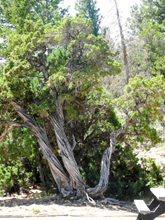 |
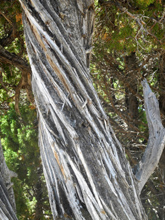 |
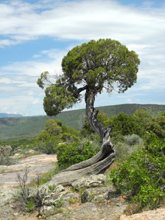 |
|
| Tree in Echo Park | Another Echo Park tree | In the Black Canyon of the Gunnison National Park | |
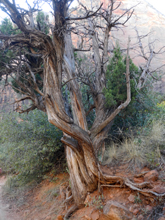 |
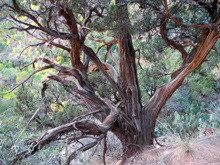 |
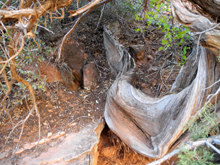 |
|
|
Juniper along
the Emerald Pools |
One of many
delightful rugged Utah junipers along the trail |
Sculptured root along Emerald Pool Trail | |
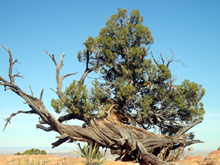
|
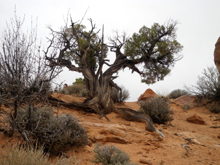 |
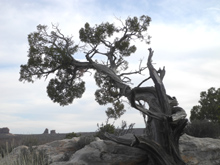 |
|
|
Juniper on Devil's Garden Trail, Arches National Park |
Twisted Utah juniper near Balanced Rock | Another Arches National Park juniper | |
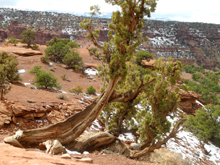 |
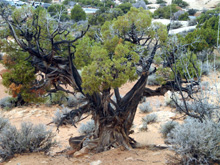 |
||
| Juniper
at Sunset Point in Capitol Reef National Park, Utah |
Another Balanced Rock area juniper | ||
| Links of Interest | |||
| Sierra Juniper | Utah Juniper | Rocky Mountain Juniper | |
| Photos | Photos | Photos | |
| Junipers in the USA | Dick's Conifer Photos | USDA Guide Rocky Mountain Juniper | |
| Grow Your Own | Great Basin National Park | Dinosaur National Monument | |
| June Lake Loop | Grand Canyon National Park | Arches National Park | |
| Canyonlands National Park | |||

